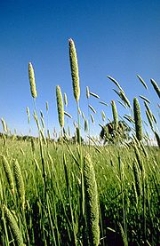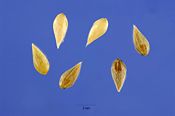
Phalaris aquatica
Encyclopedia
Phalaris aquatica, syn. P. tuberosa, known by the common names Bulbous canarygrass and Harding grass, is a species of grass
in the genus Phalaris
of the Poaceae
Family.
Phalaris arundinacea ('Reed canary grass') differs from Harding grass in having more distinct rhizomes and an inflorescence that is compact at first but later becomes more open as the branches spread.
Hybrids of Harding grass and reed canary grass have been produced. Varieties include 'AQ1', 'Uneta', and 'Australis'.
, which can cause brain damage, other organ damage, central nervous system
damage and death in sheep.
Leaves and seedlings contain the tryptamine
hallucinogens
DMT
, 5-MeO-DMT
and related compounds. A raw, dried plant Phalaris aquatica contains approximately 0.1% DMT
, 0.022% 5-MeO-DMT
, and 0.005% bufotenin
. A particular strain of P. aquatica from Italy, labeled 'AQ-1', was reported to contain in excess of 1.0% alkaloid concentration.

in grassland
, oak woodland
, and chaparral
, and riparian
habitat
s. The California native grasses in rangelands and native grasslands are affected.
Grass
Grasses, or more technically graminoids, are monocotyledonous, usually herbaceous plants with narrow leaves growing from the base. They include the "true grasses", of the Poaceae family, as well as the sedges and the rushes . The true grasses include cereals, bamboo and the grasses of lawns ...
in the genus Phalaris
Phalaris (grass)
Phalaris is a genus of grasses. Various species of Phalaris grow on every continent except Antarctica. They can be found in a broad range of habitats from below sea level to thousands of feet above sea level and from wet marshy areas to dry places. P. arundinacea and P...
of the Poaceae
Poaceae
The Poaceae is a large and nearly ubiquitous family of flowering plants. Members of this family are commonly called grasses, although the term "grass" is also applied to plants that are not in the Poaceae lineage, including the rushes and sedges...
Family.
Description
It is an erect, waist-high, stout perennial bunch grass with grayish to bluish green leaves. Flowering heads are dense, spike-like, and usually two to five inches long. It is slow to develop from seed, but can form large bunches after several years.Phalaris arundinacea ('Reed canary grass') differs from Harding grass in having more distinct rhizomes and an inflorescence that is compact at first but later becomes more open as the branches spread.
Hybrids of Harding grass and reed canary grass have been produced. Varieties include 'AQ1', 'Uneta', and 'Australis'.
Toxicity
Some Phalaris species contain gramineGramine
Gramine is a naturally occurring indole alkaloid present in several plant species. Gramine may play a defensive role in these plants, since it is toxic to many organisms.-Occurrence:...
, which can cause brain damage, other organ damage, central nervous system
Central nervous system
The central nervous system is the part of the nervous system that integrates the information that it receives from, and coordinates the activity of, all parts of the bodies of bilaterian animals—that is, all multicellular animals except sponges and radially symmetric animals such as jellyfish...
damage and death in sheep.
Leaves and seedlings contain the tryptamine
Tryptamine
Tryptamine is a monoamine alkaloid found in plants, fungi, and animals. It is based around the indole ring structure, and is chemically related to the amino acid tryptophan, from which its name is derived...
hallucinogens
Psychedelics, dissociatives and deliriants
This general group of pharmacological agents can be divided into three broad categories: psychedelics, dissociatives, and deliriants. These classes of psychoactive drugs have in common that they can cause subjective changes in perception, thought, emotion and consciousness...
DMT
Dimethyltryptamine
N,N-Dimethyltryptamine is a naturally occurring psychedelic compound of the tryptamine family. DMT is found in several plants, and also in trace amounts in humans and other mammals, where it is originally derived from the essential amino acid tryptophan, and ultimately produced by the enzyme INMT...
, 5-MeO-DMT
5-MeO-DMT
5-MeO-DMT is a powerful psychedelic tryptamine. It is found in a wide variety of plant and psychoactive toad species and, like its close relatives DMT and bufotenin , it has been used as an entheogen by South American shamans for thousands of years.-Chemistry:5-MeO-DMT was first synthesized in...
and related compounds. A raw, dried plant Phalaris aquatica contains approximately 0.1% DMT
Dimethyltryptamine
N,N-Dimethyltryptamine is a naturally occurring psychedelic compound of the tryptamine family. DMT is found in several plants, and also in trace amounts in humans and other mammals, where it is originally derived from the essential amino acid tryptophan, and ultimately produced by the enzyme INMT...
, 0.022% 5-MeO-DMT
5-MeO-DMT
5-MeO-DMT is a powerful psychedelic tryptamine. It is found in a wide variety of plant and psychoactive toad species and, like its close relatives DMT and bufotenin , it has been used as an entheogen by South American shamans for thousands of years.-Chemistry:5-MeO-DMT was first synthesized in...
, and 0.005% bufotenin
Bufotenin
Bufotenin , or 5-hydroxy-dimethyltryptamine , is a tryptamine related to the neurotransmitter serotonin...
. A particular strain of P. aquatica from Italy, labeled 'AQ-1', was reported to contain in excess of 1.0% alkaloid concentration.

Invasive species
Harding Grass is an invasive speciesInvasive species
"Invasive species", or invasive exotics, is a nomenclature term and categorization phrase used for flora and fauna, and for specific restoration-preservation processes in native habitats, with several definitions....
in grassland
Grassland
Grasslands are areas where the vegetation is dominated by grasses and other herbaceous plants . However, sedge and rush families can also be found. Grasslands occur naturally on all continents except Antarctica...
, oak woodland
California oak woodland
California oak woodland is a plant community found throughout the California chaparral and woodlands ecoregion of California in the United States and northwestern Baja California in Mexico...
, and chaparral
Chaparral
Chaparral is a shrubland or heathland plant community found primarily in the U.S. state of California and in the northern portion of the Baja California peninsula, Mexico...
, and riparian
Riparian zone
A riparian zone or riparian area is the interface between land and a river or stream. Riparian is also the proper nomenclature for one of the fifteen terrestrial biomes of the earth. Plant habitats and communities along the river margins and banks are called riparian vegetation, characterized by...
habitat
Habitat
* Habitat , a place where a species lives and grows*Human habitat, a place where humans live, work or play** Space habitat, a space station intended as a permanent settlement...
s. The California native grasses in rangelands and native grasslands are affected.
See also
- Psychedelic plantsPsychedelic plantsA list of plants that are used for psychedelic drugs. Some of them have been used for thousands of years for religious purposes. The plants are listed according to the substances they contain.-THC:Cannabis is a popular psychedelic plant...
- Invasive grasses of North AmericaInvasive grasses of North AmericaGrasses are one of the most abundant floras on all continents except Antarctica. Their divergence is estimated to have taken place 200 million years ago. Humans have intentionally and unintentionally introduced these species to North America through travel and trade. On the North American plains,...
- Invasive plant species

